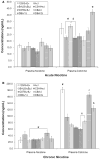Strain-dependent effects of acute, chronic, and withdrawal from chronic nicotine on fear conditioning
- PMID: 21822688
- PMCID: PMC3788685
- DOI: 10.1007/s10519-011-9489-7
Strain-dependent effects of acute, chronic, and withdrawal from chronic nicotine on fear conditioning
Abstract
The effects of nicotine on cognitive processes such as learning and memory may play an important role in the addictive liability of tobacco. However, it remains unknown whether genetic variability modulates the effects of nicotine on learning and memory. The present study characterized the effects of acute, chronic, and withdrawal from chronic nicotine administration on fear conditioning, somatic signs, and the elevated plus maze in 8 strains of inbred mice. Strain-dependent effects of acute nicotine and nicotine withdrawal on contextual fear conditioning, somatic signs, and the elevated plus maze were observed, but no association between the effects of acute nicotine and nicotine withdrawal on contextual fear conditioning were observed, suggesting that different genetic substrates may mediate these effects. The identification of genetic factors that may alter the effects of nicotine on cognition may lead to more efficacious treatments for nicotine addiction.
Figures



Similar articles
-
Genetic background influences the effects of withdrawal from chronic nicotine on learning and high-affinity nicotinic acetylcholine receptor binding in the dorsal and ventral hippocampus.Psychopharmacology (Berl). 2013 Jan;225(1):201-8. doi: 10.1007/s00213-012-2808-8. Epub 2012 Jul 27. Psychopharmacology (Berl). 2013. PMID: 22836371 Free PMC article.
-
Nicotine withdrawal-induced deficits in trace fear conditioning in C57BL/6 mice--a role for high-affinity beta2 subunit-containing nicotinic acetylcholine receptors.Eur J Neurosci. 2009 Jan;29(2):377-87. doi: 10.1111/j.1460-9568.2008.06580.x. Eur J Neurosci. 2009. PMID: 19200240 Free PMC article.
-
Sex differences in contextual fear conditioning and extinction after acute and chronic nicotine treatment.Biol Sex Differ. 2024 Oct 31;15(1):88. doi: 10.1186/s13293-024-00656-6. Biol Sex Differ. 2024. PMID: 39482781 Free PMC article.
-
Associative learning, the hippocampus, and nicotine addiction.Curr Drug Abuse Rev. 2008 Jan;1(1):9-19. doi: 10.2174/1874473710801010009. Curr Drug Abuse Rev. 2008. PMID: 19630701 Review.
-
Effects of nicotine in experimental animals and humans: an update on addictive properties.Handb Exp Pharmacol. 2009;(192):335-67. doi: 10.1007/978-3-540-69248-5_12. Handb Exp Pharmacol. 2009. PMID: 19184655 Free PMC article. Review.
Cited by
-
Nicotine disrupts safety learning by enhancing fear associated with a safety cue via the dorsal hippocampus.J Psychopharmacol. 2017 Jul;31(7):934-944. doi: 10.1177/0269881117695861. Epub 2017 Mar 14. J Psychopharmacol. 2017. PMID: 28675115 Free PMC article.
-
Impairment of contextual fear extinction by chronic nicotine and withdrawal from chronic nicotine is associated with hippocampal nAChR upregulation.Neuropharmacology. 2016 Oct;109:341-348. doi: 10.1016/j.neuropharm.2016.06.032. Epub 2016 Jul 1. Neuropharmacology. 2016. PMID: 27378334 Free PMC article.
-
Cellular, molecular, and genetic substrates underlying the impact of nicotine on learning.Neurobiol Learn Mem. 2014 Jan;107:108-32. doi: 10.1016/j.nlm.2013.08.004. Epub 2013 Aug 22. Neurobiol Learn Mem. 2014. PMID: 23973448 Free PMC article. Review.
-
c-Jun-N-terminal kinase 1 is necessary for nicotine-induced enhancement of contextual fear conditioning.Neurosci Lett. 2016 Aug 3;627:61-4. doi: 10.1016/j.neulet.2016.05.048. Epub 2016 May 25. Neurosci Lett. 2016. PMID: 27235579 Free PMC article.
-
Genetic relationship between ethanol-induced conditioned place preference and other ethanol phenotypes in 15 inbred mouse strains.Behav Neurosci. 2014 Aug;128(4):430-45. doi: 10.1037/a0036459. Epub 2014 May 19. Behav Neurosci. 2014. PMID: 24841742 Free PMC article.
References
-
- Auerbach AB, Norinsky R, Ho W, Losos K, Guo Q, Chatterjee S, Joyner AL. Strain-dependent differences in the efficiency of transgenic mouse production. Transgenic Res. 2003;12(1):59–69. - PubMed
-
- Balogh SA, Wehner JM. Inbred mouse strain differences in the establishment of long-term fear memory. Behav Brain Res. 2003;140(1–2):97–106. - PubMed
-
- Benowitz NL. Drug therapy. Pharmacologic aspects of cigarette smoking and nicotine addition. N Engl J Med. 1988;319(20):1318–1330. - PubMed
-
- Benowitz NL, Jacob P., III Metabolism of nicotine to cotinine studied by a dual stable isotope method. Clin Pharmacol Ther. 1994;56(5):483–493. - PubMed
Publication types
MeSH terms
Substances
Grants and funding
LinkOut - more resources
Full Text Sources
Molecular Biology Databases

